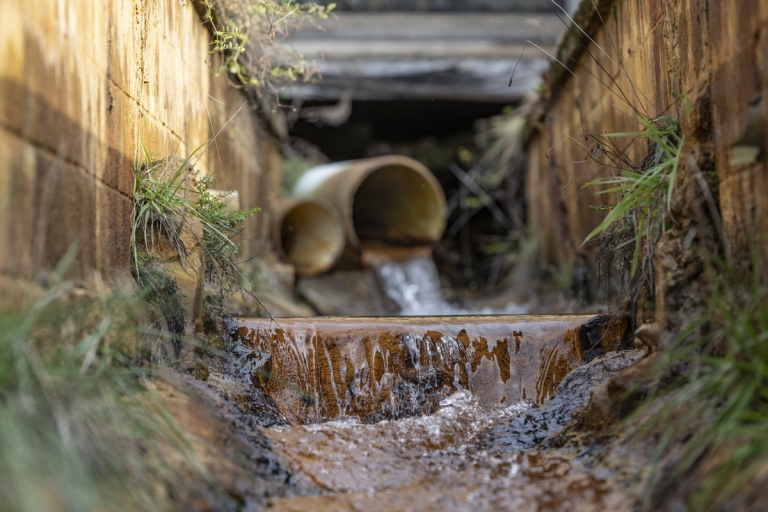
MORGANTOWN, W.Va. — West Virginia University researchers will continue to develop and advance their pioneering method to extract and separate rare earth elements and critical minerals from acid mine drainage and coal waste, courtesy of $8 million in new funding from the U.S. Department of Energy.
The grant, part of President Joe Biden’s Investing in America agenda, will lead to the design, construction and operation of a pre-commercial demonstration facility for separating and refining rare earth elements and critical minerals, according to Paul Ziemkiewicz, project lead and director of the West Virginia Water Research Institute at WVU.
Rare earth element technologies, which power everything from smartphones to the nation’s missile guidance system, could serve as a game changer for the environment and the domestic economy, according to Fred King, university Vice President for Research.
“Their work will not only help address acid mine drainage across West Virginia, but the eventual construction and operation of the pre-commercial demonstration facility will create employment in regions of West Virginia impacted by the United States’ transition away from fossil fuels,” King said.
“We are grateful for the U.S. Department of Energy and our state and federal government leaders for helping WVU advance this novel approach to extracting rare earth elements and critical minerals from acid mine drainage that Paul and his team have developed.”
Ziemkiewicz’s team has selected several candidate sites in West Virginia for this facility. It has initiated engagement with a broad range of stakeholders, including state and local legislative bodies, environmental and community-based economic development groups, AMD-treatment operators, trade unions, and technology providers.
“Using AMD as a feedstock has several community and environmental advantages,” said Ziemkiewicz, who has testified before the U.S. Senate on his research. “These are already permitted sites, which facilitates the move to production, and exploration is easy: just sample the site’s AMD discharges.
"Also, we’re not opening a new mine or disturbing a lot of ground, and we don’t produce radioactive byproducts like most conventional rare earth mines. Also, acid mine drainage provides rare earths in a form that is easily recovered, so no rock grinding nor intensive processing is needed. As a result, our carbon footprint is much less than a conventional mining and milling operation. Finally, our main byproduct is clean water since our process separately recovers the rare earths and all the other metals from AMD.”
The funding was announced as part of the Bipartisan Infrastructure Law to bring critical mineral supply chains to the U.S. and reduce reliance on competitors like China. The U.S. imports more than 80 percent of its rare earth elements and critical minerals.
Ziemkiewicz projects that the facility will produce between 5.4 and 7.3 percent of the global requirements for Terbium and Dysprosium, two of the most sought-after and critical rare earth elements. He and his colleagues have studied and refined the process since 2016 in collaboration with the Department of Energy.
“These previous efforts culminated in a technology package suitable for demonstration-scale deployment as well as an innovation ecosystem and research infrastructure, which will be leveraged for this project,” Ziemkiewicz said.
He added that over 60 percent of the rare earths in AMD are neodymium, praseodymium, and the heavy REEs most utilized in green energy and defense technologies. That number far surpasses the 12 percent HREE produced at typical REE mines.
Ziemkiewicz’s work is already making an impact, as his team has worked with the West Virginia Department of Environmental Protection to construct an AMD/REE pilot plant near Mount Storm.
That facility can treat up to 500 gallons per minute of AMD from an adjacent coal property while producing nearly two tons per year of REEs and CMs in the form of mixed oxides. The Mount Storm site is online producing compliant discharge water, and as of Sept. 2022, the system began production of hydraulic pre-concentrate.
“Unlike most academic research, our team has focused on developing large-scale, continuous operations that, with this new funding, can move the technology rapidly toward the market,” Ziemkiewicz said.
“This has meant developing private and public sector partnerships with Rockwell Automation, L3Eng, SNF Chemicals, Solmax, Endress and Hauser as well as the West Virginia DEP. Without their technologies and real-world expertise, we’d still be working at the laboratory scale.”
The newly announced project includes ongoing team members Aaron Noble of Virginia Tech and Tom Larochelle of L3Eng. Battelle Memorial Institute will provide technology integration, market, and facility construction skills.
“This award is a testament to the innovative research Paul and his team have broken ground on in recent years,” King said. “It’s also representative of the University’s collaborative approach to academic investigation and our commitment to WVU’s land-grant mission.”
Jake Stump, director of WVU Research Communications, contributed this story. jake.stump@mail.wvu.edu
Sign up to receive a FREE copy of West Virginia Explorer Magazine in your email weekly. Sign me up!




























